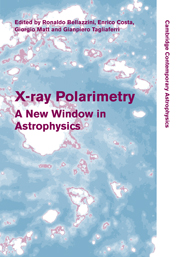Book contents
- Frontmatter
- Contents
- List of contributors
- Preface
- 1 X-ray polarimetry: historical remarks and other considerations
- Part I Polarimetry techniques
- Part II Polarized emission in X-ray sources
- Part III Future missions
- 37 Gravity and Extreme Magnetism SMEX (GEMS)
- 38 Programs of X-ray polarimetry in Italy
- 39 A polarimeter for IXO
- 40 Polarimetry with ASTRO-H soft gamma-ray detector
- 41 The Energetic X-ray Imaging Survey Telescope and its polarization sensitivity
- 42 PoGOLite: a balloon-borne soft gamma-ray polarimeter
- 43 Studies of neutron background rejection in the PoGOLite polarimeter
- 44 Observing polarized X-rays with PoGOLite
- 45 Pre-flight qualification tests of the PoGOLite detector system
- 46 The Gamma-RAy Polarimeter Experiment (GRAPE) balloon payload
- 47 POLAR: an instrument dedicated to GRB polarization measurement
- 48 Polarization detection capability of GRIPS
- 49 X-ray and γ-ray polarimetry small-satellite mission PolariS
- 50 GAP aboard the solar-powered sail mission
- 51 Hard X-ray polarimeter for small-satellite missions
- 52 Performance of hard X-ray polarimeter: PHENEX
- 53 GRB polarimetry with POET
- Author index
- Subject index
51 - Hard X-ray polarimeter for small-satellite missions
from Part III - Future missions
Published online by Cambridge University Press: 06 July 2010
- Frontmatter
- Contents
- List of contributors
- Preface
- 1 X-ray polarimetry: historical remarks and other considerations
- Part I Polarimetry techniques
- Part II Polarized emission in X-ray sources
- Part III Future missions
- 37 Gravity and Extreme Magnetism SMEX (GEMS)
- 38 Programs of X-ray polarimetry in Italy
- 39 A polarimeter for IXO
- 40 Polarimetry with ASTRO-H soft gamma-ray detector
- 41 The Energetic X-ray Imaging Survey Telescope and its polarization sensitivity
- 42 PoGOLite: a balloon-borne soft gamma-ray polarimeter
- 43 Studies of neutron background rejection in the PoGOLite polarimeter
- 44 Observing polarized X-rays with PoGOLite
- 45 Pre-flight qualification tests of the PoGOLite detector system
- 46 The Gamma-RAy Polarimeter Experiment (GRAPE) balloon payload
- 47 POLAR: an instrument dedicated to GRB polarization measurement
- 48 Polarization detection capability of GRIPS
- 49 X-ray and γ-ray polarimetry small-satellite mission PolariS
- 50 GAP aboard the solar-powered sail mission
- 51 Hard X-ray polarimeter for small-satellite missions
- 52 Performance of hard X-ray polarimeter: PHENEX
- 53 GRB polarimetry with POET
- Author index
- Subject index
Summary
We present here the design and estimated sensitivity of a hard X-ray polarimeter suitable for a small-satellite mission. Polarization fraction and direction of the X-rays from astronomical objects will be measured by recording the azimuthal anisotropy in the intensity of X-rays subsequent to their Thomson scattering on a circular disk of a light element like Li or Be. Extreme care is taken to make the instrument as azimuthally symmetric as possible and thus avoid spurious anisotropies from being seen. After describing the design of the present instrument, we present a semi-analytic calculation of the angular distribution of the scattered X-rays, taking explicitly into account the competing effects of photoelectric absorption. Thereafter, we derive the sensitivity of the instrument to measure the polarization fraction and the direction for astronomical sources with two possible spectral characteristics – a power law and thermal bremsstrahlung.
Introduction
The study of the polarization of X-ray sources may justifiably be called the next frontier in X-ray astronomy. Such measurements can reveal the physics and astrophysics under extreme conditions that are obtained in the presence of intense magnetic fields and strong gravity surrounding compact objects like pulsars and black holes and those encountered in high Mach number shocks. X-ray polarimetry of astronomical sources is a deep and sensitive probe of the astrophysical conditions that are obtained in these sources. Polarized X-rays are generated through a wide range of physical processes: synchrotron radiation, inverse-Compton scattering of low-energy polarized photons, curvature and thermal radiation in the intense magnetic fields in the polar caps of pulsars, cyclotron emission in neutron star and magnetar magnetic fields, and Thomson scattering from anisotropic systems like jets, disks and plane parallel atmospheres.
- Type
- Chapter
- Information
- X-ray PolarimetryA New Window in Astrophysics, pp. 345 - 349Publisher: Cambridge University PressPrint publication year: 2010



